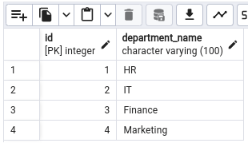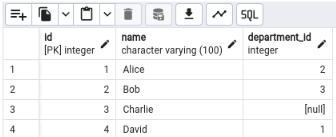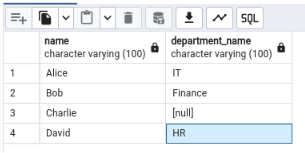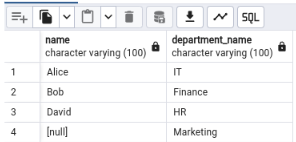SQL LEFT JOIN vs. LEFT OUTER JOIN
SQL is a powerful tool for interacting with relational databases. When working with tables in SQL, you often need to combine data from multiple tables. This is where JOIN operations help. LEFT JOIN and LEFT OUTER JOIN are two commonly used commands. Although they seem different, they actually perform the same function. Let’s understand the working and difference between SQL LEFT JOIN vs. LEFT OUTER JOIN.
Table of contents
- What is a LEFT JOIN?
- What is a LEFT OUTER JOIN?
- SQL LEFT JOIN vs. LEFT OUTER JOIN
- Practical Examples: LEFT JOIN and LEFT OUTER JOIN
- Step 1: Create Database
- Step 2: Create Tables
- Step 3: Insert Data into Tables
- Step 4: Run the Queries
- Conclusion
- Frequently Asked Questions
What is a LEFT JOIN?
A LEFT JOIN is a type of SQL JOIN operation that combines rows from two tables based on a related column. The key feature of a LEFT JOIN is that it returns all rows from the left table and the matched rows from the right table. If there’s no match, the result will include NULL values for columns from the right table.
Syntax
SELECT columns FROM left_table LEFT JOIN right_table ON left_table.column_name = right_table.column_name;
In the above syntax:
- left_table: The primary table from which all rows are returned.
- right_table: The secondary table from which matched rows are returned.
- column_name: The column used to join the two tables.
Example of LEFT JOIN
SELECT employees.name, departments.department_name FROM employees LEFT JOIN departments ON employees.department_id = departments.id;
This query retrieves all employees and their corresponding department names. If an employee is not assigned to any department, the result will show NULL for the department name.
Also Read: Joins In SQL – Inner, Left, Right and Full Joins Explained
What is a LEFT OUTER JOIN?
The LEFT OUTER JOIN operates exactly like the LEFT JOIN. It returns all rows from the left table and the matched rows from the right table. If there’s no match, it returns NULL for columns from the right table. The term “OUTER” is optional and does not change the behavior of the JOIN. It’s often used for clarity in some SQL dialects.
Syntax
SELECT columns FROM left_table LEFT OUTER JOIN right_table ON left_table.column_name = right_table.column_name;
Using the same example as above, we could rewrite our query as follows:
As you can see, the syntax is identical to the LEFT JOIN. The only difference is the inclusion of the word OUTER.
Example of LEFT OUTER JOIN
SELECT employees.name, departments.department_name FROM employees LEFT OUTER JOIN departments ON employees.department_id = departments.id;
This query also retrieves all employees and their corresponding department names, just like the LEFT JOIN. If an employee is not assigned to any department, the result will show NULL for the department name.
Also Read: SQL Guide from Basics to Advance Level
SQL LEFT JOIN vs. LEFT OUTER JOIN
While the termsLEFT JOINandLEFT OUTER JOINmay appear different, they are functionally identical in SQL. The only difference lies in the syntax:
- LEFT JOIN: Shorter and more commonly used.
- LEFT OUTER JOIN: Includes the optional“OUTER”keyword for clarity.
Both commands return the same results, so the choice between them is a matter of personal or organizational preference.
Practical Examples: LEFT JOIN and LEFT OUTER JOIN
To create a sample database with employees and departments tables, and then use the LEFT JOIN and RIGHT JOIN examples, you can use the following SQL commands.
Step 1: Create Database
First, create the database where the tables will reside.
SELECT columns FROM left_table LEFT JOIN right_table ON left_table.column_name = right_table.column_name;
Step 2: Create Tables
Now, let’s create the employees and departments tables.
SELECT employees.name, departments.department_name FROM employees LEFT JOIN departments ON employees.department_id = departments.id;
Step 3: Insert Data into Tables
Now, insert some sample data into both tables:
SELECT columns FROM left_table LEFT OUTER JOIN right_table ON left_table.column_name = right_table.column_name;
Output:

SELECT employees.name, departments.department_name FROM employees LEFT OUTER JOIN departments ON employees.department_id = departments.id;
Output:

Step 4: Run the Queries
Now that the database and tables are created and populated with data, you can run the LEFT JOIN and RIGHT JOIN queries.
LEFT JOIN Query
CREATE DATABASE company_db; USE company_db;
Output:

RIGHT JOIN Query
-- Create the 'departments' table
CREATE TABLE departments (
id INT PRIMARY KEY,
department_name VARCHAR(100) NOT NULL
);
-- Create the 'employees' table
CREATE TABLE employees (
id INT PRIMARY KEY,
name VARCHAR(100) NOT NULL,
department_id INT,
FOREIGN KEY (department_id) REFERENCES departments(id)
);Output:

When to Use LEFT JOIN or LEFT OUTER JOIN
- Data Retrieval: Use a LEFT JOIN when you need all records from the left table, even if there are no matching records in the right table.
- Reporting: Ideal for generating reports where you want to include all items (e.g., products, employees) regardless of their relationships.
- Data Analysis: Helps identify gaps or missing relationships between datasets.
Conclusion
In summary, both LEFT JOIN and LEFT OUTER JOIN are synonymous terms in SQL that serve the same purpose of combining data from two tables while ensuring that all records from the left table are included in the result set. The choice between using one term over the other often comes down to personal or organizational preference. Understanding this can enhance your efficiency when writing SQL queries and prevent confusion during data manipulation tasks.
Put your SQL knowledge to test with these SQL Projects!
Frequently Asked Questions
Q1. What is the difference between LEFT JOIN and LEFT OUTER JOIN?A. There is no difference. LEFT JOIN and LEFT OUTER JOIN are functionally identical. The term “OUTER” is optional and used for clarity.
Q2. When should I use a LEFT JOIN?A. Use a LEFT JOIN when you need all records from the left table, even if there are no matching records in the right table.
Q3. Does LEFT JOIN include NULL values?A. Yes, a LEFT JOIN returns NULL values for columns from the right table when there is no match for a row in the left table.
Q4. Can I use LEFT JOIN and LEFT OUTER JOIN interchangeably?A. Yes, you can use LEFT JOIN and LEFT OUTER JOIN interchangeably in SQL queries. Both produce the same results.
The above is the detailed content of SQL LEFT JOIN vs. LEFT OUTER JOIN. For more information, please follow other related articles on the PHP Chinese website!

Hot AI Tools

Undresser.AI Undress
AI-powered app for creating realistic nude photos

AI Clothes Remover
Online AI tool for removing clothes from photos.

Undress AI Tool
Undress images for free

Clothoff.io
AI clothes remover

Video Face Swap
Swap faces in any video effortlessly with our completely free AI face swap tool!

Hot Article

Hot Tools

Notepad++7.3.1
Easy-to-use and free code editor

SublimeText3 Chinese version
Chinese version, very easy to use

Zend Studio 13.0.1
Powerful PHP integrated development environment

Dreamweaver CS6
Visual web development tools

SublimeText3 Mac version
God-level code editing software (SublimeText3)

Hot Topics
 1664
1664
 14
14
 1422
1422
 52
52
 1316
1316
 25
25
 1268
1268
 29
29
 1240
1240
 24
24
 Getting Started With Meta Llama 3.2 - Analytics Vidhya
Apr 11, 2025 pm 12:04 PM
Getting Started With Meta Llama 3.2 - Analytics Vidhya
Apr 11, 2025 pm 12:04 PM
Meta's Llama 3.2: A Leap Forward in Multimodal and Mobile AI Meta recently unveiled Llama 3.2, a significant advancement in AI featuring powerful vision capabilities and lightweight text models optimized for mobile devices. Building on the success o
 10 Generative AI Coding Extensions in VS Code You Must Explore
Apr 13, 2025 am 01:14 AM
10 Generative AI Coding Extensions in VS Code You Must Explore
Apr 13, 2025 am 01:14 AM
Hey there, Coding ninja! What coding-related tasks do you have planned for the day? Before you dive further into this blog, I want you to think about all your coding-related woes—better list those down. Done? – Let’
 AV Bytes: Meta's Llama 3.2, Google's Gemini 1.5, and More
Apr 11, 2025 pm 12:01 PM
AV Bytes: Meta's Llama 3.2, Google's Gemini 1.5, and More
Apr 11, 2025 pm 12:01 PM
This week's AI landscape: A whirlwind of advancements, ethical considerations, and regulatory debates. Major players like OpenAI, Google, Meta, and Microsoft have unleashed a torrent of updates, from groundbreaking new models to crucial shifts in le
 Selling AI Strategy To Employees: Shopify CEO's Manifesto
Apr 10, 2025 am 11:19 AM
Selling AI Strategy To Employees: Shopify CEO's Manifesto
Apr 10, 2025 am 11:19 AM
Shopify CEO Tobi Lütke's recent memo boldly declares AI proficiency a fundamental expectation for every employee, marking a significant cultural shift within the company. This isn't a fleeting trend; it's a new operational paradigm integrated into p
 GPT-4o vs OpenAI o1: Is the New OpenAI Model Worth the Hype?
Apr 13, 2025 am 10:18 AM
GPT-4o vs OpenAI o1: Is the New OpenAI Model Worth the Hype?
Apr 13, 2025 am 10:18 AM
Introduction OpenAI has released its new model based on the much-anticipated “strawberry” architecture. This innovative model, known as o1, enhances reasoning capabilities, allowing it to think through problems mor
 A Comprehensive Guide to Vision Language Models (VLMs)
Apr 12, 2025 am 11:58 AM
A Comprehensive Guide to Vision Language Models (VLMs)
Apr 12, 2025 am 11:58 AM
Introduction Imagine walking through an art gallery, surrounded by vivid paintings and sculptures. Now, what if you could ask each piece a question and get a meaningful answer? You might ask, “What story are you telling?
 Newest Annual Compilation Of The Best Prompt Engineering Techniques
Apr 10, 2025 am 11:22 AM
Newest Annual Compilation Of The Best Prompt Engineering Techniques
Apr 10, 2025 am 11:22 AM
For those of you who might be new to my column, I broadly explore the latest advances in AI across the board, including topics such as embodied AI, AI reasoning, high-tech breakthroughs in AI, prompt engineering, training of AI, fielding of AI, AI re
 3 Methods to Run Llama 3.2 - Analytics Vidhya
Apr 11, 2025 am 11:56 AM
3 Methods to Run Llama 3.2 - Analytics Vidhya
Apr 11, 2025 am 11:56 AM
Meta's Llama 3.2: A Multimodal AI Powerhouse Meta's latest multimodal model, Llama 3.2, represents a significant advancement in AI, boasting enhanced language comprehension, improved accuracy, and superior text generation capabilities. Its ability t




